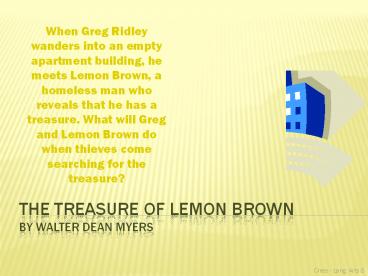The Treasure of lemon brown by Walter dean myers - PowerPoint PPT Presentation
Title:
The Treasure of lemon brown by Walter dean myers
Description:
When Greg Ridley wanders into an empty apartment building, he meets Lemon Brown, a homeless man who reveals that he has a treasure. What will Greg and Lemon Brown do ... – PowerPoint PPT presentation
Number of Views:637
Avg rating:3.0/5.0
Title: The Treasure of lemon brown by Walter dean myers
1
The Treasure of lemon brownby Walter dean myers
When Greg Ridley wanders into an empty apartment
building, he meets Lemon Brown, a homeless man
who reveals that he has a treasure. What will
Greg and Lemon Brown do when thieves come
searching for the treasure?
2
Author Walter dean myers
- Born 1937 in West Virginia, but spent most of his
life in Harlem, NYC. - Raised by foster parents, his life was happy but
chaotic. - He grew up with a speech impediment. Writing
became a habit and he acquired an early love of
reading. - In 1954, he quit high school and joined the army.
3
- He supports his wife and four children through
his writing. - He volunteers at schools in Jersey City, NJ,
where he currently lives. - On his writing for young peopleYoung people
need ideals which identify them, and their lives,
as centralguideposts which tell them what they
can be, should be, and indeed are. - -Walter Dean Myers
4
Elements of a short story (PLOT)
- Identifying the Elements of A Plot Diagram
3
2
4
1
5
5
PLOT (definition)
- Plot is the organized pattern or sequence of
events that make up a story. Every plot is made
up of a series of incidents that are related to
one another.
6
1. Exposition
- This usually occurs at the beginning of a short
story. Here the characters are introduced. We
also learn about the setting of the story. Most
importantly, we are introduced to the main
conflict (main problem).
7
2. Rising Action
- This part of the story begins to develop the
conflict(s). A building of interest or suspense
occurs.
8
3. Climax
- This is the turning point of the story. Usually
the main character comes face to face with a
conflict. The main character will change in some
way.
9
4. Falling Action
- All loose ends of the plot are tied up. The
conflict(s) and climax are taken care of.
10
5. Resolution
- AKA Denoeument
- The story comes to a reasonable ending.
11
Putting It All Together
1. Exposition 2. Rising Action 3. Climax 4.
Falling Action 5. Resolution
Beginning of Story
Middle of Story
End of Story
12
Elements of a short story (continued)
- Setting- The time and place in which the story
takes place. - Conflict-The struggle in the story.
- Person vs. Person the leading character
struggles against another character. - Person vs. Self the leading character struggles
against his or her own self. - Person vs, Society the leading character
struggles against a population. - Person vs. Nature the leading character
struggles against fate/events.
13
Point(s) of view
- First person- Narrator participates in the action
of the story. - Second person- Narrator tells the story to
another character, referring to them as you. - Third person- Narrator does not participate in
the action is not one of the characters. An
outside voice. - Limited- Narrators knowledge is limited to only
one character, either major or minor. - Omniscient- Knows EVERYTHING, knows all
thoughts/feelings from every character in the
story.
14
Characters
- Protagonist- The central character in a written
piece. - Antagonist- Character(s) in conflict with the
main character - Minor Character(s)- Those in the background who
dont play a major role.
15
Mood, Style, and tone
- Mood- Effect of the writers words on the reader.
- This story made me really sad ?
- Style- How the writers expression sets him or
her apart from other writers. - O. Henry uses much bigger words than any author
Ive ever read before! Why is he so wordy? - Tone- Authors attitude toward the subject.
- The author seems to suggest that we should all
treat homeless people the same way the
protagonist treated Lemon Brown































